Evaluation Of Asian Option By Using RBF Approximation
Price
Free (open access)
Transaction
Volume
42
Pages
8
Published
2006
Size
317 kb
Paper DOI
10.2495/BEM060041
Copyright
WIT Press
Author(s)
E. Kita, Y. Goto, F. Zhai & K. Shen
Abstract
This paper describes the evaluation of the price of the Asian option by using the radial bases function (RBF) approximation. In the previous study, we described the evaluationmethod of the European and the American options. In this paper, the Asian option is considered. A governing differential equation is discretized with the Crank-Nicholson scheme and the RBF approximation. The system of equations is solved for the option price. The numerical results are compared with the FDM solutions in order to confirm the validity of the formulation. 1 Introduction Recently, financial derivatives have been widely used and their importance has increased. The importance of the derivative transaction is increasing for the adequate sharing of the financial risk. The option transaction is one of the most important financial derivatives and therefore, several schemes have been presented by many researchers for their pricing [1, 2]. Several financial options have been developed; the European option, American option, Look-Back option, Exotic option and so on. In previous studies, the authors described the pricing of the European and American options [3, 4]. The Asian option will be considered in this paper. In the Asian option, the payoff is performed according to the time-average value of the asset price. The Asian option can be classified into the average rate option, the average strike option and so on.While, in the former, the payoff depends on the difference between the time-average value of the asset of the asset price and the expiration price, in the latter, the payoff depends on the difference between the average value and the asset price on an expiration date. In this paper, we focused on the average strike option.
Keywords





